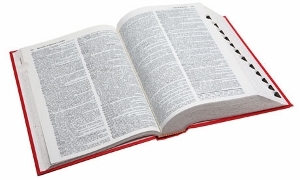Kathy Lynn Emerson's Blog, page 99
August 4, 2015
The Boothbay Home and Garden Tour
Hi. Barb here, working away on the porch in Boothbay Harbor, Maine. So far today we’ve had rain, fog, cool wind, sun, humidity, heat and repeat. Waiting for the hail.
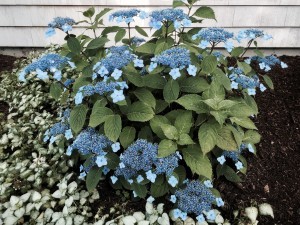 On July 24, my husband Bill and I went on the Boothbay Home and Garden Tour, sponsored by the Boothbay Region Garden Club. We love these types of tours and often take them when we are in Key West in the winter, but this was my first time in Boothbay.
On July 24, my husband Bill and I went on the Boothbay Home and Garden Tour, sponsored by the Boothbay Region Garden Club. We love these types of tours and often take them when we are in Key West in the winter, but this was my first time in Boothbay.
Why do we do this? Well, because the houses and gardens are lovely, that’s for sure. I have always loved houses, beautiful houses, big houses, old houses, tree houses. You name it. And house porn is my favorite kind of porn. Whenever I am in need of mindless entertainment, I head straight for HGTV. My favorite episodes of House Hunters are the ones where a twenty-three year old bride with a deep Texas accent looks at a room that would make a nice child’s bedroom here in the crowded northeast and says, “That’s the master closet?” (shudder) “I just couldn’t live like that.” Somehow that sort of thing never fails to amuse me.
 My excuse for taking the day off from writing was that I was looking for settings, since my series takes place in an area very like Boothbay Harbor. And I did get some good ideas.
My excuse for taking the day off from writing was that I was looking for settings, since my series takes place in an area very like Boothbay Harbor. And I did get some good ideas.
But the main reason I go on these tours is because I am nosy as heck. I just love to see how people live and what better way than to tour five houses? Or actually ten houses, since four of the five had guest houses and one had both a guest house and a carriage house. (Which might have seemed excessive, if the carriage house hadn’t looked like the best writing studio ever.)
 And the houses were gorgeous, and luxurious. “I’ve finally learned to go on these things without envy,” I heard a man say to his wife. “Think of them like house museums,” I told him. “You can look but you can’t touch.” Of course, then I did remind my husband on the way home to buy a lottery ticket.
And the houses were gorgeous, and luxurious. “I’ve finally learned to go on these things without envy,” I heard a man say to his wife. “Think of them like house museums,” I told him. “You can look but you can’t touch.” Of course, then I did remind my husband on the way home to buy a lottery ticket.
Unfortunately, the houses were all heavily staged, as if for sale, so my nosiness was unrequited. Not that I blame the owners. I don’t think I’d leave personal stuff about if my house was going to be trekked through by hundreds of people, either.
You could tell the gardeners from the house people on the tour. My attitude toward the gardens is, “Oh, how beautiful!” but I have no interest in discussing what plant is what, or how to cultivate it. I want to see fine furniture and antiques and paintings and views, views, views. And I got everything I wished for.
Enjoy!

The octagonal room on the right side of this photo is a library/study lined with bookshelves in dark wood with a writing desk at the center with a view of the harbor and islands. Think you could work there?

This house was the oldest on the tour, the “in town” house, with a wonderful mural in the dining room.

Here’s the front garden for the house at left.

This screened porch was beautiful–complete with stone fireplace for those cool Maine evenings. Another place I could work.

The hydrangreas on the water-side of the house were humungous.
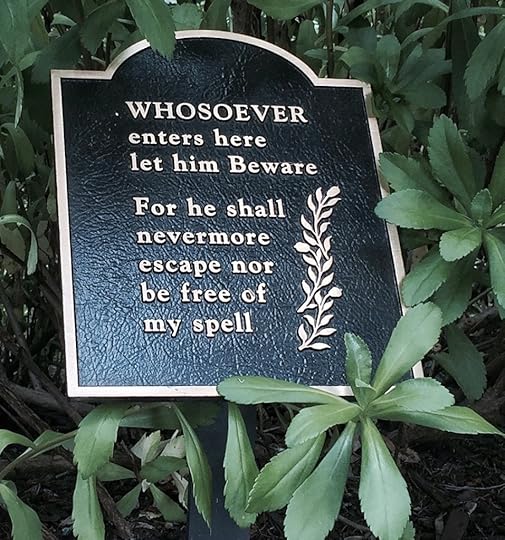
I thought this garden sign was a little creepy–not the usual soothing sentiments. Googling tells me the quote comes from the gate to the rose garden at Lynch Park in Beverly, MA. But I don’t know what the original quote comes from–if anything. Does anyone know?

The dock out front.
August 3, 2015
Porch Sitting
Lea Wait, here, enjoying summer in Maine. Temperatures and humidity have been a bit higher than usual this summer, but compared to other parts of the country we have nothing to complain about. (Although occasionally we complain anyway. I suspect complaining about weather is part of human DNA.)
When I used to vacation in Maine for two or three weeks in the summer I swallowed the Maine experience in large gulps. Sometimes literally. I ate lobsters, clams, scallops, mussels, haddock, salmon … every day at least once. I went on boat rides. I attended auctions and checked out flea markets and antique shops and shows. I read as much as I could, when I wasn’t at a farmer’s market, or picking blueberries, or shopping the outlets with my daughters for back-to-school-and-work clothes. The many gift and craft shops in our area provided a good start on my Christmas gift shopping.
In short … being in Maine meant doing everything I loved to do, that my life in New York or New Jersey couldn’t provide. 
Now that I live here, though, there are no vacations. Sure, I eat more seafood than I did when I lived in other places. (The lobsters pictured in my kitchen sink are dinner.) And my husband (who does most of our cooking) checks out a couple of farmers’ markets each week.
But this year I’m under deadline. My next mystery (Shadows on a Morning in Maine, the eighth in my Shadows Antique Print Mystery series,) is due to the editor September 1. My fellow Maine Crime Writes refer to this period of last-month panic as “writers’ jail.” No vacationing involved.
Still, it is summer in Maine, so I try to sneak in bits of outside time. A walk. An occasional day-trip. And, most often, I sit on my porch, overlooking the Sheepscot River. If I’m there during the day it’s usually because I’m editing the hard copy of pages I’ve written. Yesterday about 150 pages I thought were well-secured escaped … flying all over the porch and (a few) into the yard. Bob and I raced after them, grateful that, yes, they had page numbers. If it’s 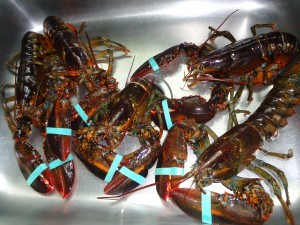 late in the day, I’m sipping wine (or lemonade, if I’ll be working later that night) accompanied by Bob, and often, by neighbors who find our porch welcoming. Friends sometimes bring their own libations and nibbles. A couple of days ago neighbors even brought their own glasses!
late in the day, I’m sipping wine (or lemonade, if I’ll be working later that night) accompanied by Bob, and often, by neighbors who find our porch welcoming. Friends sometimes bring their own libations and nibbles. A couple of days ago neighbors even brought their own glasses!
We don’t ask them to do that. But it’s become a quiet summer ritual.
Sitting, sipping, nibbling, enjoying late afternoon sea breezes and the company of friends … every day it makes me thankful that I’m lucky enough to live and work on the coast of Maine. The gift shops and boat rides will wait.
In the meantime, when I’m not in my study, you can find me on my porch. No place is better. 
August 2, 2015
An Amazing Journey
Russell Warnburg: I begin my eighth decade on this mortal plain with great gratitude for 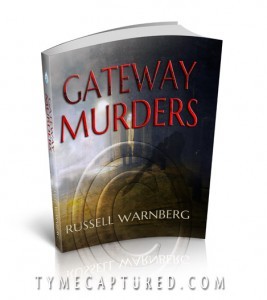 a long and satisfying life. My writing career did not begin until I was 66, in my final year of teaching. I began teaching in Lewiston, then taught in Minneapolis, followed by 21 years in Gray, and ended in Windham. Having come through two bouts of cancer, a third if you count a small skin lesion, I knew it was time to begin that novel I had planned to write since my college days. My first novel was Edge of Redemption that was released in 2012, followed by Chalk Line Killer and Gateway Murders. These three are part of the Detective Cole Sullivan series, all set primarily in Maine, as is my fifth novel that will come out next year.
a long and satisfying life. My writing career did not begin until I was 66, in my final year of teaching. I began teaching in Lewiston, then taught in Minneapolis, followed by 21 years in Gray, and ended in Windham. Having come through two bouts of cancer, a third if you count a small skin lesion, I knew it was time to begin that novel I had planned to write since my college days. My first novel was Edge of Redemption that was released in 2012, followed by Chalk Line Killer and Gateway Murders. These three are part of the Detective Cole Sullivan series, all set primarily in Maine, as is my fifth novel that will come out next year.
 After getting my first novel published, I decided a goal was necessary, so I added to my bucket list that I would write ten novels, at least one a year. In How To Become An Author, Arnold Bennett advises that: “But it must never be forgotten, that while the reputation is being formed, the…public needs continuous diplomatic treatment. It must not be permitted to ignore his existence. At least once a year and oftener if possible, a good solid well made book should be flung into the libraries.” I am attempting to follow that solid advice.
After getting my first novel published, I decided a goal was necessary, so I added to my bucket list that I would write ten novels, at least one a year. In How To Become An Author, Arnold Bennett advises that: “But it must never be forgotten, that while the reputation is being formed, the…public needs continuous diplomatic treatment. It must not be permitted to ignore his existence. At least once a year and oftener if possible, a good solid well made book should be flung into the libraries.” I am attempting to follow that solid advice.
I have now reached 71, and wait for my fourth novel, 2064 A Warning, that will be released October 1st. It is a dystopian novel and also a love story between two young lovers, Robert and Celia, who struggle to survive in a very difficult and tragic future. There may be a sequel but who knows? Right now I am interested in continuing the Sullivan series.
While I am in the quoting mood, I thought it worthwhile to pass on something of interest by P.G. Wodehouse. In a letter to his friend Bill in 1945:
“You say you tend to get tired nowadays. Me, too. After all, we’re both heading for seventy. Silver threads among the gold, laddie. Extract from a book I was reading the other day: ‘Latterly his mind had been going to seed rather. He was getting toward seventy, you see.’ Have you ever noticed, by the way, what peculiar ideas writers have as to what constitutes old age? ‘He was a man not far from fifty, but still erect and able to cross the room under his own steam,’ they write. Or ‘Old though the Squire was, his forty-six years sat lightly upon him.’ At sixty eight I have reached the stage when, picking up a novel and finding that new character the author has introduce is sixty, I say to myself, ‘Ah, the young love interest.’ ”
 My thoughts exactly. Isn’t this ability to tell a story something? And somehow my mind is not going to seed, nor am I feeling tired. I have become a story teller and wouldn’t trade it for the world. I must admit, however, that there are infrequent times when I wonder if all this hard work is worth it, but then something, anything will trigger an idea and that creative urge bubbles back to the surface. That urge is not always satisfied by writing however. Sometimes I paint, design and build a piece of furniture, or get an idea for an interesting photograph. A few years back I displayed some of my furniture and photos at Gallery 302 in Bridgeton and sold a few of each.
My thoughts exactly. Isn’t this ability to tell a story something? And somehow my mind is not going to seed, nor am I feeling tired. I have become a story teller and wouldn’t trade it for the world. I must admit, however, that there are infrequent times when I wonder if all this hard work is worth it, but then something, anything will trigger an idea and that creative urge bubbles back to the surface. That urge is not always satisfied by writing however. Sometimes I paint, design and build a piece of furniture, or get an idea for an interesting photograph. A few years back I displayed some of my furniture and photos at Gallery 302 in Bridgeton and sold a few of each.
I have always wondered why I must create. I have a hunch that some of you reading this, have wondered the same thing.
July 31, 2015
Weekend Update: August 1-2, 2015
 Next week at Maine Crime Writers there will be posts by Lea Wait (Tuesday), Barb Ross (Wednesday), John Clark (Thursday) and Maureen Milliken (Friday),with a special guest post from Russ Warnberg on Monday.
Next week at Maine Crime Writers there will be posts by Lea Wait (Tuesday), Barb Ross (Wednesday), John Clark (Thursday) and Maureen Milliken (Friday),with a special guest post from Russ Warnberg on Monday.
In the news department, here’s what’s happening with some of us who blog regularly at Maine Crime Writers:
from Kathy Lynn Emerson/Kaitlyn Dunnett: Next weekend I will be one of the Wilton authors participating in this year’s Wilton Blueberry Festival. The theme is “Reading and Writing” and I’ll be reading from my books, answering questions about writing, and signing books at the Wilton Free Public Library from 2-3 PM on Friday, August 7. I will have both current and backlist titles available for purchase.
And on Sunday, August 2, Lea Wait, Maureen Milliken and Vaughn Hardacker will be at the Maine Crime Writers booth at Belgrade’s juried Lakeside Artisan Show, 1 Center Drive, in Belgrade, from 9 a.m. until 3 p.m. Their books will be available for purchase and signing — of course! Crafts and books – what could be more fun! (Christmas gifts, anyone?)
from Barb Ross: On Monday, August 3, at 7:00 pm I’ll be at the Witherle Memorial Library in Castine, Maine, speaking as a part of their Maine Writers Series.
And in case you’ve resisted us until now, in August, Vampires, Bones and Treacle Scones, (Liss MacCrimmon Mystery Book 7) by Kaitlyn Dunnett, Twisted Threads, (Mainely Needlepoint Mystery Book 1) by Lea Wait, and Clammed Up, (Maine Clambake Mystery Book 1) by Barbara Ross will be on sale for $1.99 in various ebook formats all month.
An invitation to readers of this blog: Do you have news relating to Maine, Crime, or Writing? We’d love to hear from you. Just comment below to share.
And a reminder: If your library, school, or organization is looking for a speaker, we are often available to talk about the writing process, research, where we get our ideas, and other mysteries of the business. Contact Kate Flora: mailto: kateflora@gmail.com
July 30, 2015
Words, Words, and More Words
 Kathy Lynn Emerson/Kaitlyn Dunnett here, today musing on the English language, the origins of words, and some of their meanings.
Kathy Lynn Emerson/Kaitlyn Dunnett here, today musing on the English language, the origins of words, and some of their meanings.
Every year, major dictionaries add more words. Some have been around for quite a while before they officially become part of the English language. Others make the cut quickly, thanks in part to their frequent appearance in social media. This year, in May, Merriam-Webster added 1,700 new words.
Many aren’t all that new. Some aren’t exactly words at all. Take “WTF” for example. I hope I don’t have to tell you what the letters stand for. It’s classed as an “abbreviation,” that is “used especially to express or describe outraged surprise, recklessness, confusion of bemusement.” Hmmm.
“Selfie” made Merriam-Webster list. So did “frenemy” and “twerk.” More on that last one in a minute.
 A little over a month later, in June, the Oxford English Dictionary, affectionately known as the OED, also added new words. It also created new sub-entries and added new senses to the meanings of words already in the dictionary. I couldn’t find a total number of “new” words, but suffice it to say that “a whole bunch” covers it.
A little over a month later, in June, the Oxford English Dictionary, affectionately known as the OED, also added new words. It also created new sub-entries and added new senses to the meanings of words already in the dictionary. I couldn’t find a total number of “new” words, but suffice it to say that “a whole bunch” covers it.
The OED is a resource frequently used by writers because it makes every effort to trace each word to its earliest use in print in English. This helps writers of historical novels avoid anachronisms. Sometimes, when the OED assures us a word was in use much earlier than we thought, we still avoid using it because it just doesn’t “sound right” for the period. Case in point: the updated OED traces the meaning of “twerk” back to 1820. Who knew?
Of local interest here in Maine is the addition of the word “Masshole” as a term of contempt for someone from Massachusetts. The OED dates this word to c.1989. Personally, I’d date it a lot earlier, and apply it specifically to people in cars with Massachusetts license plates driving recklessly on Maine roads. That’s the thing about words—not only are they often in use far earlier than their first appearance in print, but their meanings tend to vary from region to region.
Other goodies from the OED list are:
carnapping
crowdfunding
declutter
e-edition
forensics
hard-bodied
meh (adjective and interjection)
netbook
retweet
webisode
wuss
 Some of these started out as made-up words. Now they’re real. Hey, this is nothing new. Shakespeare alone is credited with adding over 1,700 words to the English language. They weren’t all totally new. He changed nouns to verbs, added prefixes and suffixes, and otherwise altered meanings of existing words . . . just as someone did to create many of the words on this year’s lists. Some of my favorites among Shakespeare’s contributions to the language, with particular emphasis on those relating to crime and criminals, are bandit, circumstantial, cold-blooded, and premeditated. The Bard of Avon also gets credit for “obscene.”
Some of these started out as made-up words. Now they’re real. Hey, this is nothing new. Shakespeare alone is credited with adding over 1,700 words to the English language. They weren’t all totally new. He changed nouns to verbs, added prefixes and suffixes, and otherwise altered meanings of existing words . . . just as someone did to create many of the words on this year’s lists. Some of my favorites among Shakespeare’s contributions to the language, with particular emphasis on those relating to crime and criminals, are bandit, circumstantial, cold-blooded, and premeditated. The Bard of Avon also gets credit for “obscene.”
Don’t you just love a living language?
Kathy Lynn Emerson/Kaitlyn Dunnett is the author of over fifty books written under several names. She won the Agatha Award in 2008 for best mystery nonfiction for How to Write Killer Historical Mysteries and was an Agatha Award finalist in 2014 in the best mystery short story category for “The Blessing Witch.” Currently she writes the contemporary Liss MacCrimmon Mysteries (Ho-Ho-Homicide, 2014) as Kaitlyn and the historical Mistress Jaffrey Mysteries as Kathy (Murder in the Queen’s Wardrobe, 2015). The latter series is a spin-off from the Face Down series and is set in Elizabethan England. Her webpages are www.KathyLynnEmerson.com and www.KaitlynDunnett.com
Gutting it out in a Funky Summer

Larry’s recently rehabbed garden
John Clark slowly recovering from a hernia repair. I had one fixed back in 1981 and I can tell you, my body at 67 sure doesn’t bounce back like it did at age 33. As things stand, I’m not allowed to lift anything heavier than 10 pounds for six weeks and can’t drive for at least one more week. Boxes of books sneer as I waddle past and I can hear the back lawn giggling every time it rains.
Each time I’m tempted to do something stupid, I remember what happened the day I got out of the hospital back when the first one was repaired. I hadn’t planned on fruit trees arriving at an inopportune time when I was diagnosed and surgery was scheduled, so imagine my chagrin (yes liberals were allowed to possess up to 8 ounces of chagrin in the early 1980s) when the UPS driver backed into the driveway and handed me a long box. If I’d had any common sense, I would have thought of someone I could call and ask to plant the trees, but that wasn’t in the cards, so I grabbed a shovel and started digging. I wasn’t down more than six inches when I felt a pop and a burning sensation. Fortunately, it was only one stitch, but that was enough to convince me to be ultra careful as I finished excavating three holes for the new trees. My folly resulted in no permanent damage and there was an unexpected bright side to the whole hernia experience. I ended up being out of work for seven weeks and it was a real eye-opener. I’d started working regularly at age eleven, mostly in the blueberry fields, but in a neighbor’s poultry barn as well. Until the forced medical leave, I’d pretty much been a workaholic. To realize that there was life outside of the workplace was a complete amazement and altered my outlook significantly.
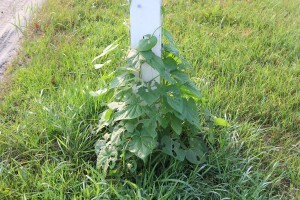
Morning Glory vines on their way to hiding the mailbox
Times have changed in terms of what’s done and how they do it. This time around, it was day surgery and involved three small incisions and a miniature camera wandering around my belly, followed by the sewing into place of a mesh screen and then having the incisions glued with a variation on the super glue we use to repair household items. Even so, that was a week ago and I’m still bent over and trying not to hobble a lot. Fortunately the post office, the library and the grocery store are two blocks away, but the recent spate of rainstorms washed a lot of mud down to the edge of the sidewalk, particularly in sloped driveways. Yesterday, I was about to say hello to some young veggie salesmen who were selling garden goodies down the street when my foot hit some of the really slippery mud. Next thing I knew, I was doing my James Bond martini imitation—shaken, but not stirred. All I could think about as I desperately tried to maintain my balance was ‘hope to hell I don’t pop anything.”

Partial view of our raised bed
On to a garden status report. Last year, Brenda Seekins who is a local master gardener, asked about having an informal gathering at the library of people interested in sharing garden wisdom, seeds, plants while getting answers and inspiration. We met four times and developed a core group. In October, we agreed at the final meeting to resume in April of 2015. The group had our third meeting last night. Even though we all live within a four mile radius, what has happened to our gardens this summer shows some significant variation. Before I get into those, let me backtrack and share some of the things I’ve heard in my travels and conversations during the growing season. It started with a chat I had with a man in Detroit who sells hay and straw. He also grows plants for seed purposes for a Maine company. He said that the month of June was the worst he could remember in terms of growing weather. It was too cold and too wet, causing seed rot and real difficulty getting into his fields to plant.

Zuke, Zuke, Zuke of Earl
His observations were mirrored in a conversation I had a couple weeks later with a friend from Canaan who is an organic gardener. He went even further, noting that even stuff in hoop houses wasn’t growing very well thanks to the chill. The next piece of information came from Joe, the man who services our furnace. We were talking about picking strawberries and he noted that his wife had gone to a nearby pick your own place a couple days earlier and when she returned, she said the owners had told her that last winter was extremely hard on strawberry plants, resulting in significant winter kill. This was reinforced when it took me almost a week to find a day when Sites Farm in Athens was open for picking. The berries were nice, but got picked out very quickly each morning. Before leaving the field, I checked out their high bush blueberries. From what I could see, there won’t be any shortage in that crop.
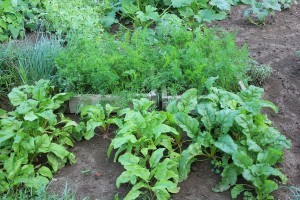
Beets (less 2 messes of greens) and carrots
Both people I encountered at the post office and those in the gardening group lamented the effect June’s cold and damp had on certain crops. Sweet corn has been a disaster for everyone in the group. I planted three times before giving up. I have two lone stalks and gave the rest of the row to a late planting of turnips. Zucchini and summer squash required a second planting before anything worthwhile showed above ground. Likewise for cucumbers and winter squash. While both came up, six weeks later, they’re sitting there looking dazed and nary a blossom is visible. Peas and green beans came in very spotty, necessitating a second planting in between what did come up, but both are now healthy and close to being ready for picking. After discovering an almost full packet of yellow bean seeds, I planted them in mid-July and it looks like every seed germinated overnight.

Our two lonely cornstalks and the row of turnips that replaced the ones that didn’t make it.
Beets, carrots, parsnips and broccoli all did well from seed, but four very hungry woodchucks decimated the red and green cabbage as well as all but one of our cauliflower. While we have yet to see a single deer track, folks on the other side of the Sebasticook river here in Hartland, can’t keep them out of garden spots. Unlike several people I’ve talked to, who all bemoaned the terrible luck they were having with tomatoes, our five varieties are not only thriving, but have been producing ripe fruit for a couple weeks. Finally, I’m very happy to report that there are fruit clusters on the grape vines and we’ve already picked two gallons of raspberries. While it’s still early, the apple crop also looks pretty promising.

Our lone cauliflower, soon to be at the heart of a steamy and cheesy affair.
Flowers, particularly perennials, seem to have an immunity to weather foibles. Our raised bed garden is a sea of color and the small garden my neighbor, Larry, let me rehabilitate (it had become a sea of milkweed, pigweed and crabgrass) will soon feature Tithona, morning glory, calendula and hollyhock in bloom. He was happy and it allowed me to find a home for extra plants. Larry also let me reclaim the vegetable garden behind his house that was sliding back into wilderness. It’s pretty eye-opening what a good zero-turn mower can do to a Maine jungle. Three hours of rototilling later and it was serviceable. I have a row of lettuce, some broccoli from seed and another 40 or so golden hubbard squash plants growing there. Potatoes and sunflowers I planted didn’t even give me the time of day. I’d be extremely interested in hearing what your gardening experiences have been this year.
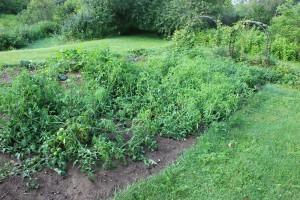 Peppers are always a conundrum. Last year huge leafy plants with no peppers. This year, small, but loaded they be.
Peppers are always a conundrum. Last year huge leafy plants with no peppers. This year, small, but loaded they be.
July 28, 2015
We Love Maine Mystery Writers
Our guest blogger today is Mainely Murders, a bookstore in Kennebunk that specializes in mysteries, talking about Maine crime writers who are popular with their patrons.
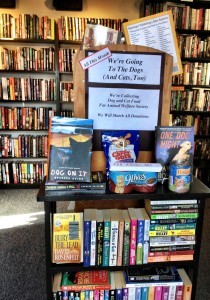 At Mainely Murders, our five-year-old mystery bookstore in Kennebunk, we love Maine crime writers. And, for the multitude who call Maine home (even for only part of the year), there’s a mystery for every taste—from the very cozy to the darkly noir.
At Mainely Murders, our five-year-old mystery bookstore in Kennebunk, we love Maine crime writers. And, for the multitude who call Maine home (even for only part of the year), there’s a mystery for every taste—from the very cozy to the darkly noir.
From the time we opened our doors (blood-red, of course), Maine mysteries have occupied a special place here—literally. Walk in, and there, just to the right of the door, are the shelves of Maine (and New England) writers. We also try very hard to have a strong backlist of these authors, and while we are primarily a used bookstore, we do sell new releases of our favorite authors.
While Maine books take up a relatively small part of our store, they are the first books that many summertime visitors head for when they enter. Whether looking for a title that will remind them of their vacation or eager to find a new (to them) writer, they often ask for recommendations. Because of the regional nature of much of the book business, some popular New England writers, for example, are virtually unknown elsewhere.
Indeed, unless their favorite writers and books top the New York Times Bestsellers list—or have inspired a made-for-TV movie or series—book buyers in general rely on recommendations. And our local customers are especially faithful to Maine writers once they learn about them.
This year, we’re focusing even more attention on Maine authors.
Now through September 15, those who purchase any book (new or used, hardback or 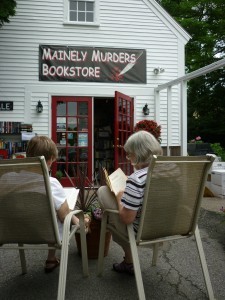 paper) by a Maine crime writer will be entered into our Maine mystery writers contest. No restrictions on how often can enter; one entry for each book purchased.
paper) by a Maine crime writer will be entered into our Maine mystery writers contest. No restrictions on how often can enter; one entry for each book purchased.
Since May, we’ve already well ahead of last year’s sales of books by Maine writers. But, the best news is that customers—both local and from away—have returned and asked for more.
So, who sells at Mainely Murders (keeping in mind that we maintain fairly extensive backlists of many authors?)
Beginning with The Poacher’s Son, readers have embraced Paul Doiron’s Mike Bowditch series. Last year, he was our best-selling Maine writer and ranked in the top 10 of all authors we carry. With each new book, he’s picked up new readers who invariably want to go back to the beginning and read them in order. For those who have followed him through Trespasser, Bad Little Falls, Massacre Pond, The Bone Orchard, and, now, The Precipice, there’s always the, “Call me when the next one comes out.”
Gerry Boyle’s Jack McMorrow books have been a favorite of mine since Deadline (1993), long before I became a mystery bookseller. A combination of a wonderfully clear, sharp writing style and a newspaper reporter protagonist—two clear-cut winners in my book—have made the McMorrow titles among my most highly recommended. (Thank you, thank you, Islandport Press, publisher of McMorrow #10, Once Burned, for its decision to reprint the earlier titles.)
Paul Doiron and Gerry Boyle share many readers. Mike Bowditch and Jack McMorrow aren’t that much different. Neither one is adverse to bending a few rules whether in Maine’s north woods, carrying a badge, or in its small towns, with a press pass.
On the distaff side, two of our favorite writers, Barbara Ross and Lea Wait, share readers in their new series. They also share a theme, young women returning home to Maine to save family businesses.
Customers who pick up the first of Barb Ross’ Maine Clambake Mysteries (Clammed Up) generally return for the two (Boiled Over and Musselled Out) that follow. We’re then happy to tell them Barb has signed a contract for three additional titles.
When Lea Wait, whose Shadow titles are very popular with our customers, published her first Mainely Needlepoint Mystery (Twisted Threads) this spring, our customers snatched it up. We now have a waiting list for her next two—Threads of Evidence (August 25) and Thread and Gone (December 29). We’re now delighted to share the news that she’s signed another three-book contract.
Others who consistently rank among our big sellers are John Connolly, Sarah Graves, Kate Flora, Kathy Lynn Emerson/Kristen Dunnett , Tess Gerritsen, B.B. Haywood, and Katherine Hall Page, especially her Sanpere Island stories.
Because we focus on used titles, supplemented by new releases, we generally have the backlist of least some, if not all, titles by many writers. (That holds true of our stock in general. While our small shop holds about 3,500 titles, our inventory of more than 10,000 books is accessible.)
One thing we’ve learned in the last five years is that big name authors don’t need booksellers like us hand selling their titles. If you’re wondering, I’ve never recommended a book by James Patterson, nor do I ever expect to.
What we will continue to do is introduce many wonderful Maine crime writers to readers both from here and away.
Mainely Murders Bookstore, owned by Paula Keeney and Ann Whetstone, is located at 1 Bourne Street, Kennebunk, ME 04043. To subscribe to our monthly e-mail newsletter, visit www.mainelymurders.com.
July 27, 2015
Steal This Idea!
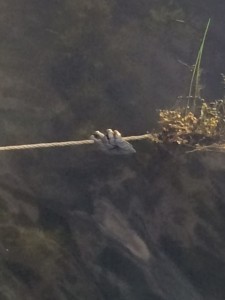
An escaped lobsterman’s glove, tangled in a rope. But doesn’t it look like more than that?
Kate Flora: Yesterday, Maureen Milliken wrote a post about the value of conversation to a writer. She’s so right. It’s impossible to underestimate the importance of talking to people in the know when you’re writing in a genre that requires detailed knowledge about the world of crime. As Maureen wrote, there are a lot of things we need to research in order to get them right, and we work in a genre where our readers are sharp, and quick to call us on it when we don’t do our research.
If you’ve been reading this blog for a while, though, you will know how I like to harp (oh, is that too negative a word or does harp put you in mind of lovely music?) on the subject of imagination. I’ve even taken my interest in prodding writers to use their imaginations as far as teaching a class for Grub Street from time to time called, “Imagine This.” Any student who has ever taken a class with me knows how often I urge those with a desire to write to pull out their earbuds, turn off their screens, and look at the world—and the people—around them to see the fabulous story ideas that are happening all around them all the time.
Once, years ago, I got the assignment to write the Afterword for a magazine. I decided to write about imagination, and since I was at one of those very cool parties that happen at conventions, with a room full of A-list writers, I decided to ask random people what came to mind when I used the word: Imagination. Far too many people reacted like it was a trick question, instead of saying: what we use all the time when we are writing.
This past weekend, I spent far too much time in my car dashing from one writerly event
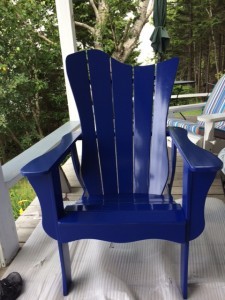
The goofy blue chair I just finished putting together.
to another—events that were great fun, but which took me away from my writing desk, and the work that is calling to me. While I was driving, I was listening to NPR, and heard some interviews with E.L Doctorow, including this quote:
The thing about writing is that you use your imagination a good deal of the time and you can usually work out things by thinking about them and imagining them. That’s the whole game – to get into people’s skins, to pretend to be someone you’re not, to have experiences you’ve never had and to represent them truly to render them. E.L. Doctorow in an interview with Terry Gross on NPR
One of the things that happens when we look around, and let the things we see prod our imaginations, is we begin to ask the question: What is that about? Who is that about? What happened just before this? What is going to happen next?
For example, what is driving that chubby, heavily tattooed man in the diner in Falmouth to want to wear that ratty-looking semi-automatic weapon on his belt?
How did a folding chair, a sleeping bag, a beach towel, and assorted other gear come to be rolling around in the road just north of Portland and how will the owners feel when they realize it is gone?
What is the significance of that wreath of plastic flowers and a helium balloon tied to the corpse of a dead porcupine? Is it just to make people like me wonder? An exercise of whimsical imagination?
It’s a fact. The world is full of marvelous, slightly off-beat things that prompt our questions. But just as Maureen reminds us we need to be talking to people, I’m here today to remind you to look around, see what’s there, and let it prompt your imagination 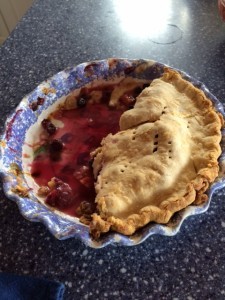 to think about the story it might tell. You don’t need a book of writing prompts, though of course they can be helpful. But you do need to look. And you need to wonder.
to think about the story it might tell. You don’t need a book of writing prompts, though of course they can be helpful. But you do need to look. And you need to wonder.
Tomorrow, I am off to Union to pick blueberries in the 18-acre field my husband gave me for my 55th birthday. And on Wednesday? Happy Birthday to me.
July 26, 2015
Writing a mystery novel? Never discount value of a good conversation.
Hi, Maureen here, on a gloomy July day in Belgrade Lakes.
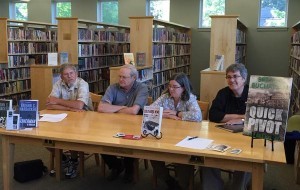
John Clark, Vaughn Hardacker, Maureen MIlliken and Brenda Buchanan talk mysteries, Maine and other stuff at the Thompson Library in Dover-Foxcroft July 14. (Diane Kenty picture)
On a much prettier typical Maine summer day two weeks ago, I made the drive up to the Thompson Library in Dover-Foxcroft, whereI and fellow contributors to this blog Brenda Buchanan and Vaughn Hardacker talked mysteries and writing to a small but appreciative audience, moderated by John Clark, who also contributes to this blog.
One of the questions to the panel concerned research, how we do it and what amount.
It’s a question I hadn’t given a lot of thought to, and my answer was that we’re always doing research. Since Cold Hard News and the upcoming novels in my Bernie O’Dea series are based near where I live and have a newspaper background, I can’t help but draw from what’s around me and what I experience on a daily basis as a newspaper editor. Aside from the usual Googling and looking things up that comes with writing, I thought that was it.
But I realized later that I’d left out a big aspect of my research: the interview.
I thought of this the other day when I finally sat down with a friend and colleague, Scott Monroe, who I’d been hounding for months to tell me about hunting, specifically about field dressing a deer in as much grisly detail as possible. I’m sure that’s info I could find on the internet, too, but there’s really nothing like talking it out with someone. Particularly when your interview victims are smart and insightful, which I always try to make mine are, it’s a goldmine. I’m sure now that my followup questions have already started and show no sign of letting up, he’s already regretting it.
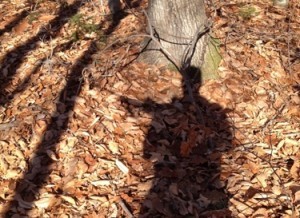
A possible piece of the cover art for the next Bernie O’Dea mystery novel, generously provided by Scott Monroe.
He’s also offered up some art that I hope will be part of the cover art of my upcoming novel, working name No News is Bad News. It’s a tradition, because he also supplied the photo that’s on the cover of Cold Hard News. Hopefully I won’t bug him so much about hunting that he takes it back.
Interviews were also a big part of Cold Hard News.
When I first started writing the book, I needed to talk to someone who was owner/editor of a weekly newspaper. Though I’d worked on dailies as a reporter, then an editor, since 1983, I knew enough about weeklies to know there was a lot I didn’t know. I was living in Manchester, N.H., at the time, and after a lot of research, found the right size paper with the right kind of owner/editor in Enosburg Falls, Vt. Ed Shamy had recently been laid off from the Burlington Free Press (this was 2009 and newspaper jobs were dropping like flies), had bought the County Courier in Enosburg Falls and was willing, though a little reluctantly, to talk to me. He said he wasn’t sure he could help me much and I said that’s okay, it’ll be painless and only take about half an hour.
Well, it ended up being nearly two hours and Ed not only gave me a lot of good detail about how a weekly operated, but also was candid and heartfelt about what it felt like to go from a big, influential daily to a little country weekly. That conversation formed the foundation Cold Hard News was built on.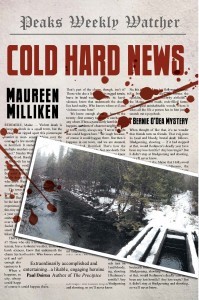
A while before that conversation, I had another one with my friend, reporter Lorna Colquhoun. Lorna, as a reporter for the New Hampshire Union Leader, had covered the Bruce McKay-Liko Kenney shootings in 2007 in Franconia, N.H. That double-fatal shooting inspired a dramatic turning point in my book.
A lot of what Lorna told me was deep background and detail that didn’t make it into the book, but I needed to have the conversation to fully understand what had happened, both the people and the events, so I could have fertilizer for my thought process.
In all three cases, I fully understood that I was going to get a lot of stuff that I wasn’t going to use. That didn’t matter and none of it was a waste of time. When I was a reporter, I used to approach interviews the same way. Sure, I had some questions jotted down, but I was just as focused on what the person I was interviewing could add that I wasn’t aware of, or hadn’t given a lot of thought to.
Those two conversations for Cold Hard News, and my recent and ongoing one that will help form a big part of the book in progress are big foundation ones. But both books also were formed out of probably hundreds of small conversations I’ve had with more people, about more topics, than I can remember.
I like to talk. I don’t deny it. Anyone who knows me will vouch for it. But I also think it’s becoming a lost art. Okay, not a lost art so much as dismissed as time-wasting or not productive. We love our electronic devices, and I’m thrilled that I can text, email and message people. In a lot of cases it’s more efficient and gets the job done. But none of those are as satisfying as good old-fashioned conversation.
Next time I’m asked about my mystery writing research I’ll keep that in mind.
And be sure to stop by the Belgrade Lakeside Artisan Show next Sunday, Aug. 2, where Vaughn Hardacker, Lea Wait and I will be manning the Meet the Maine Crime Writers table. It’s 9 a.m. to 3 p.m. at the Community Center for All Seasons on Route 27.
I’d love to chat!
Maureen Milliken is the author of Cold Hard News, the first book in the Bernie O’Dea mystery series.
July 24, 2015
Weekend Update: July 25-26, 2015
 Next week at Maine Crime Writers there will be posts by Maureen Milliken (Monday), Kate Flora (Tuesday), John Clark (Thursday) and Kaitlyn Dunnett/Kathy Lynn Emerson (Friday), with a guest blog on Wednesday.
Next week at Maine Crime Writers there will be posts by Maureen Milliken (Monday), Kate Flora (Tuesday), John Clark (Thursday) and Kaitlyn Dunnett/Kathy Lynn Emerson (Friday), with a guest blog on Wednesday.
In the news department, here’s what’s happening with some of us who blog regularly at Maine Crime Writers:
Today (July 25) several of us are at the Beyond the Sea Book Festival in Lincolnville Beach, Maine. Come join us if you can. Late morning and early afternoon is the best time to find us there, as we’re signing in overlapping shifts. Attendees include Barbara Ross, Dorothy Cannell, Lea Wait, Kate Flora, Susan Vaughan, and Kaitlyn Dunnett/Kathy Lynn Emerson. The complete schedule is here: http://www.beyondtheseamaine.com/book-festival-2015.html
Barb: On Thursday evening, July 30, at 6:30 I’ll be at the G.A.R. Memorial Library in West Newbury, MA, discussing “Not Your Ordinary Cozy Mystery” with fellow Wicked Cozy Authors, Jessie Crockett, Liz Mugavero and Edith Maxwell.
Lea: And, for next weekend, Sunday, August 2, Vaughn Hardacker, Maureen Milliken and I will be at the Belgrade Lakes Artisans Show, with our books, of course, from 9 am until 3 pm. A chance to talk with us … and take home a signed book (or three!)
An invitation to readers of this blog: Do you have news relating to Maine, Crime, or Writing? We’d love to hear from you. Just comment below to share.
And a reminder: If your library, school, or organization is looking for a speaker, we are often available to talk about the writing process, research, where we get our ideas, and other mysteries of the business. Contact Kate Flora: mailto: kateflora@gmail.com

